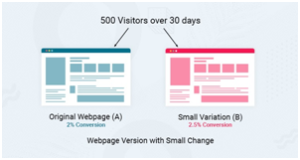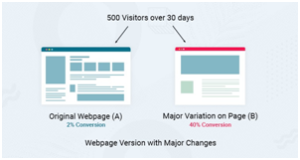
No online business can flourish if it fails to obtain the required traffic on the website. Study below for better understanding:
Traffic ↑—> Purchasers ↑—>Profits ↑
We have received a question from many people:
“Does Traffic also matter when it comes to ‘Data-Driven-Optimizations’ like CRO?”
Answer by Kinex Media: Yes, it does matter!
The testing procedures for CRO need website traffic to run several conclusive tests.
A Fact To Consider:
To gain insightful data from the web traffic is a cup of tea for long-established enterprises like Amazon & Microsoft. These websites encounter millions of users every day.
But when we are considering the low-traffic websites, we can say without a doubt, “Conversion Optimization is a big challenge here.”
So does that mean, “Small-Businesses should give up on Conversion Optimization?
‘NO!”
But that surely means that such businesses need to read this article:
What Difficulties Are Being Faced By ‘low-Traffic-Websites’?
Critical Testing tells whether a website is running optimally & generating revenue or not. Such tests heavily rely on data. For attaining significant results requires you to have a lot of data.
So ‘How To Increase Traffic On The Website?’
For that, you have to work on your website to make it appear at #1 Rank.
What If I Can’t-Wait To Make My Website Rank To Implement Best Practices Of CRO?
It’s not only you who holds such an opinion. We have encountered so many queries with the same question.
It would be difficult to wait to get your website ranked because it is time-consuming. Moreover, you are running a small business, and you wouldn’t want to spend a lot on making it rank. Right?
But, it isn’t effortless to perform CRO on your website when it does not get the required amount of traffic.
Besides that:
- The websites which encounter less traffic are the ones that have small sample sizes. It takes a lot of time to reach statistical significance when we are working on the small dimensions of the samples.
- On the other hand, calling a test much before it has reached statistical significance puts it at the risk of implementing false information. It is just like shooting yourself in the foot.
- For such reasons, A/B testing & optimizations for the low traffic websites emerge challenging for most marketers.
Guidelines: Increase Conversions Rate for Low Traffic Websites
1. Testing with Low Confidence Levels
Merit
One of the critical parts of the statistics is the confidence level. It helps you to know:
- How reliable are the findings of the test?
- How safely can you implement the false results?
Did you know?
Test results are more accurate if the confidence level is high.
It would help if you chose different confidence levels while carrying out the tests on the other samples. Select only that confidence level that accurately decides the sample size.
If you want to perform CRO based on the industry standard, escalate the confidence level to about 95%. Minimal chances worth 5% indicate that your information is false when you do so.
So Keep Your Confidence Level Reduced
When you diminish the confidence level, your test speeds up & you can achieve the results in a shorter time.
Demerit
Caution!
When you are setting the diminished confidence levels, you consent to compromise the accuracy of the test results.
It is eventually your decision whether you want to choose accuracy or time.
But I think it is okay to test at an 80% or 85% confidence level.
Tip
Rather than waiting for an enormous sample size to gain a 90% or 95% confidence level, it is better to test different variations over a short period.
2. Don’t Take Micro Conversions for Granted
Merit
Micro Conversions ——————————> Macro Conversions
It means micro conversions are an incremental step. When you reach a stage where you are making a lot of micro-conversions, you can find yourself near your macro conversions goal.
It’s a Good Idea
According to the SEO & PPC experts of Kinex Media, “We have always attained the positive results when we track the micro-conversions when we want to carry out optimizations on the low traffic websites.”
But Why Should We Track The Small Conversions?
By tracking the micro-conversions, you can get the baseline conversion. Baseline Conversion is essential for building your test around.
Did you know?
When you increase the ‘Baseline Conversion,’ the ‘Size of the Sample’ decreases which is usually essential to reach statistical significance. The Run test always comes out to be successful.
Demerit
If you are considering the tracking results of the micro-conversions, you are choosing the possibility of conducting a successful test over accuracy.
Thus, you may harm your CRO practice.
So, “How to track your micro-conversions to ensure that it comes out to be advantageous in the process of the website conversion?”
Ans: You must consider ‘Micro-conversions’ as part of the whole CRO journey. The professional must make use of these variables to uplift the user experience.
3. Do Not Think Twice To Carry Out The Major Changes
Unfortunately, you can’t enjoy the liberty of carrying out a test on the minute elements. And the expert professionals are of the view that you do not need it at this stage.
But, you can indeed carry out an A/B test.
Merit!
Making your site experience tremendous changes can uplift the effect of the primary variable.
To make it more simple, you can say, “When you are making a huge change in the variation, you can probably see the significant change in the baseline conversion.”
Why so?
Here we are explaining with the help of the examples:
The website whose web pages we have taken as an example usually experience nearly 500 Visitors per month, making it a small website.
| Small Changes | Major Changes |
 |
 |
| Before the small changes took place, the conversion rate of the original page was 2%. | Before the small changes took place, the conversion rate of the original page was 2% |
| But after the small changes, the conversion rate increased up to 2.5%, which is relatively small. | But once the significant changes took place on the site, the conversion rate increased up to 40%, which is massive. |
4. Personalization with Dynamic Data
Did you know?
About 66% of customers expect to get the online engagement personalized concerning their interactions & online behaviour.
It is the website personalization that is responsible to increase conversions.
Personalized content is tailored to the preferences of web visitors and more relevant to their interests which is built up based on search history, online behaviour, demographic information & location etc.
Who does not know ‘NETFLIX’?
The whole credit of its highest conversion goes to its personalized or user-specific content.
Wrap Up!
Be it a low or high-traffic attaining website, the ultimate goal of each of the websites is to increase conversions. For the ‘High-Traffic-Websites,’ there are certainly many ways to increase conversions effectively & in a short time. But when it comes to low-traffic websites, there are not many ways to enhance the traffic. And the existing few ones are challenging to implement. But having the correct information about the implementation can solve much of the problem.
Also Read: https://www.ezineposting.com/top-5-digital-marketing-tips-for-small-business/